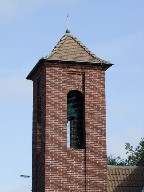| |
|
The pretty bell tower of
this 1956 church sticks its head up between the
lush trees of pleasantly suburban Yarmouth Road
in North Lowestoft. The
ancient village name is a courtesy title really;
this church is as close to the centre of
Lowestoft as the Borough parish church of St Margaret, and it is
hard to see that there was ever a village here.
There probably wasn't; Gunton Hall, with the
pretty round-towered medieval parish church of St Peter, lies some
way to the north of here, and the hall grounds
are now the home of the American theme park
Pleasurewood Hills, Suffolk's biggest tourist
attraction.
The church is quite a large one for
its age. It was designed, like nearby Oulton
Broad St Luke, to be both a parish hall
and a church. Since my last visit ten years ago,
a new extension has been added to the western
end, doubling the building in size. The red brick
and pantiled roof of the old part give it a
metroland air, quite in keeping with the Yarmouth
Road bungalows and houses of twenty years
earlier.
The bell and the
dedication are here because of the German
bombing of the city of Norwich during the
Second World War. The church of St Benedict
there was gutted in the Blitz. After the
war, the Diocese of Norwich used the war
damage reparation money to build a new
church here instead. The bell is from the
former Norwich church; but if you ignore
the tower, the older part of the church
looks as if it might actually be a large
house, because of its slightly unnerving
1950s domestic windows. You step inside
to a large entrance area, turning left
into the original church. As at St
Luke, the body of the
church is divided from the sanctuary by a
screen. The interior, with its red flush
curtains and red modern seating, is
reminiscent of a small cinema. It is all
pleasantly understated, unlike the blousy
neighbouring Mormon church, with its
hi-tech spire.
Incidentally,
although St Benedict matches
architecturally its leafy surroundings,
it isn't here to serve them. Behind it,
Hollingsworth Road is the spine road of
the large and challenging Gunton estate,
a high density 1960s housing development
built for workers in Lowestoft's many
factories of the time. Unemployment and
poverty have taken their toll, and you
hope that St Benedict has been the root
of some comfort. And it is good to think
that the bell which rang out over the
medieval tenements of Norwich workers now
sounds across the houses of their modern
counterparts.
|
|
 |
|
|
|

